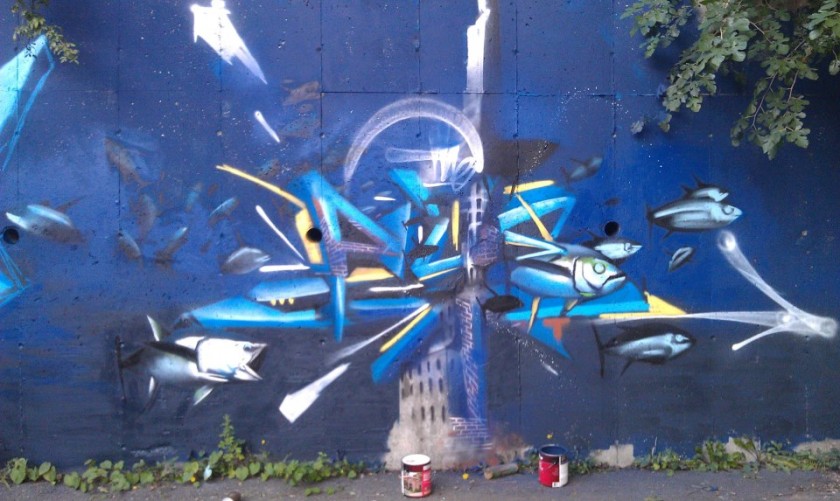Why Boston Needs To Better Nurture the Outdoor Arts Community

Used with permission from Events at Bartlett Yards
Several local arts organizations looking to expand options for those interested in outdoor murals and community-based gatherings say it’s difficult to bring residents together in the city because of the daunting, tedious process of obtaining the proper permits from various Boston departments.
On April 13, a group known as HarborArts will team up with Future Boston Alliance to bring a graffiti and outdoor arts event to East Boston at the Boston Harbor Shipyard and Marina, home to HarborArts’ outdoor gallery. The gathering will attract area artistic talent, cultivate a sense of community, and feature music from area DJs as two well-known graffiti artists, Cedric Douglas and Percy Fortini-Wright, finish a giant aquatic mural scene on the side of a wall.
But pulling all of these concepts and moving parts together wasn’t an easy task, says Matt Pollock, executive director of HarborArts. “It’s hard to do stuff in Boston. Boston doesn’t make it that easy to have a spontaneous intervention that brings people in the community together to do something cool,” says Pollock. “You have to go through so much bureaucracy.”
Because of the art group’s relationship with the shipyard, Pollock says, they were able to tie-up any loose ends and prepare for the graffiti gathering. However, getting more events similar to the “Graffiti Jam,” as it’s called, something Pollock would like to see all around Boston in various neighborhoods, is seemingly more complicated. “The city needs to support the arts more—it’s not like New York or Chicago where the arts have such a strong support system,” he says. “What we need to do is change it, we need to start budgeting for art [and more events].”
The “bureaucracy” Pollock points to is something City Councilor John Connolly discussed during his recent campaign launch for the mayoral seat, likening the permit-pulling process to the infamously bad Boston reality series “Southie Rules.” According to the Boston Globe, Connolly said the current administration’s “idea of getting an online permit to rent a park … means printing a form from a computer and hand-delivering it to City Hall.”
Malia Lazu, a member of the group Future Boston, who is co-sponsoring the HarborArts event, agrees. “Everyone who has tried to do something in this city has this story,” she says. “I’d like for there to be some consistency to the process. It shouldn’t have to go up to the Mayor for a decision. I’m not talking about some huge party shutting down [Massachusetts] Ave., I’m talking about different communities wanting to get together for small events.”
Requests sent to the mayor’s office for comment about the permitting process for these types of events were not immediately returned.
Besides HarborArts’ community get together, Lazu referenced the upcoming Bartlett Yard’s events, an art and music festival that kicks of in May and plans on drawing in dozens of talented mural painters and graffiti artists to create eye-popping pieces on old building walls slated for removal, before making way for a new development.
“When things like Bartlett Yard, they are not asking to throw a Cirque du Soliel party across [Interstate] 93, they are asking for their community to get together, and for some reason, it is not encouraged in this city. I think that the constrictions and restrictions that are on trying to do anything outside, anything in the city with certain types of people, like young people, or people of color, it becomes much more difficult to get,” says Lazu.
Jason Turgeon, one of the creative minds behind the Events at Bartlett Yard series, says the development team that recently bought the old property from the MBTA has been kind enough to allow his group to use the area as grounds for the art takeovers since the land is currently unused and will remain that way until it’s demolished and rebuilding begins.
“The whole site is eight-and-a-half acres, and it has been vacant for years,” Turgeon says, describing the scheduled events, which are planned to span over a couple weekends, as “an art free for all.”
“We want young kids in the community who have been wanting to do graffiti, who have been doing it illegally, to have a place to put their stuff. We want local kids and adults—there is a big established art scene in the area—to have a place for their stuff,” say Turgeon.
But like Lazu’s past experiences with sifting through paperwork and meeting with various city department heads to gain clearance, Turgeon still has some hurdles to overcome. “It can be impossible. [Some of this] could still not happen and we have already raised all of this money and have non-profit partners. Because the city’s process is so opaque, they have been trying to work with us, but it just doesn’t exist to move through this stuff easily,” he says.
Turgeon said the city has been supportive of the group’s efforts, but he would like to see a more streamlined approach to organizing events that foster community growth and bring arts and entertainment to Boston neighborhoods, like the Bartlett Yard’s series, which will not only feature artwork, but also dance groups, food trucks, and musical guests.
“It’s definitely not easy to organize all of this, and it’s something we are really trying to get the city to develop to make these processes easier. They are all supportive in theory, but [a streamlined process] doesn’t exist so far. There is no process for this,” he says.
For more information, check out the sites for the HarborArts event in April, and Bartlett Yard’s art festival.



